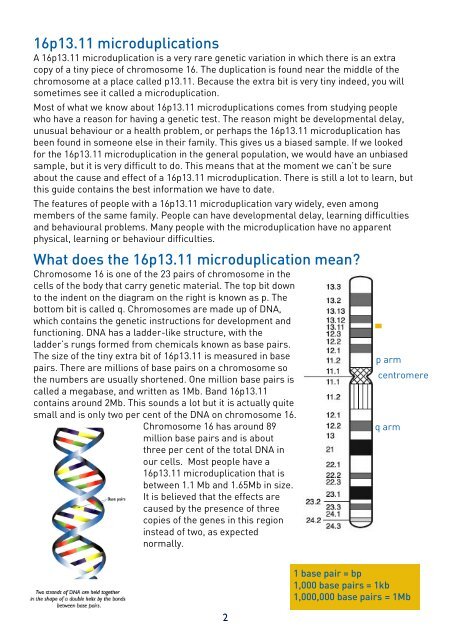16p13.11 microduplications - Unique - The Rare Chromosome ...
16p13.11 microduplications - Unique - The Rare Chromosome ...
16p13.11 microduplications - Unique - The Rare Chromosome ...
You also want an ePaper? Increase the reach of your titles
YUMPU automatically turns print PDFs into web optimized ePapers that Google loves.
<strong>16p13.11</strong> <strong>microduplications</strong><br />
A <strong>16p13.11</strong> microduplication is a very rare genetic variation in which there is an extra<br />
copy of a tiny piece of chromosome 16. <strong>The</strong> duplication is found near the middle of the<br />
chromosome at a place called p13.11. Because the extra bit is very tiny indeed, you will<br />
sometimes see it called a microduplication.<br />
Most of what we know about <strong>16p13.11</strong> <strong>microduplications</strong> comes from studying people<br />
who have a reason for having a genetic test. <strong>The</strong> reason might be developmental delay,<br />
unusual behaviour or a health problem, or perhaps the <strong>16p13.11</strong> microduplication has<br />
been found in someone else in their family. This gives us a biased sample. If we looked<br />
for the <strong>16p13.11</strong> microduplication in the general population, we would have an unbiased<br />
sample, but it is very difficult to do. This means that at the moment we can’t be sure<br />
about the cause and effect of a <strong>16p13.11</strong> microduplication. <strong>The</strong>re is still a lot to learn, but<br />
this guide contains the best information we have to date.<br />
<strong>The</strong> features of people with a <strong>16p13.11</strong> microduplication vary widely, even among<br />
members of the same family. People can have developmental delay, learning difficulties<br />
and behavioural problems. Many people with the microduplication have no apparent<br />
physical, learning or behaviour difficulties.<br />
What does the <strong>16p13.11</strong> microduplication mean?<br />
<strong>Chromosome</strong> 16 is one of the 23 pairs of chromosome in the<br />
cells of the body that carry genetic material. <strong>The</strong> top bit down<br />
to the indent on the diagram on the right is known as p. <strong>The</strong><br />
bottom bit is called q. <strong>Chromosome</strong>s are made up of DNA,<br />
which contains the genetic instructions for development and<br />
functioning. DNA has a ladder-like structure, with the<br />
ladder’s rungs formed from chemicals known as base pairs.<br />
<strong>The</strong> size of the tiny extra bit of <strong>16p13.11</strong> is measured in base<br />
pairs. <strong>The</strong>re are millions of base pairs on a chromosome so<br />
the numbers are usually shortened. One million base pairs is<br />
called a megabase, and written as 1Mb. Band <strong>16p13.11</strong><br />
contains around 2Mb. This sounds a lot but it is actually quite<br />
small and is only two per cent of the DNA on chromosome 16.<br />
<strong>Chromosome</strong> 16 has around 89<br />
million base pairs and is about<br />
three per cent of the total DNA in<br />
our cells. Most people have a<br />
<strong>16p13.11</strong> microduplication that is<br />
between 1.1 Mb and 1.65Mb in size.<br />
It is believed that the effects are<br />
caused by the presence of three<br />
copies of the genes in this region<br />
instead of two, as expected<br />
normally.<br />
p arm<br />
centromere<br />
q arm<br />
2<br />
1 base pair = bp<br />
1,000 base pairs = 1kb<br />
1,000,000 base pairs = 1Mb

















